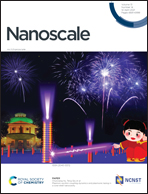Interface engineering of cobalt–sulfide–selenium core–shell nanostructures as bifunctional electrocatalysts toward overall water splitting†
Abstract
The number of active sites and stability of the structure of electrocatalysts are the key factors in the process of overall water splitting. In this paper, cobalt–sulfide–selenium (Se:CoS2−x) core–shell nanostructures are prepared by a simple two-step method, including hydrothermal reaction and chemical vapor deposition. The resulting product exhibits excellent electrochemical performance, owing to the synergistic effects between CoS2 and CoSe1−x, as well as the plentiful active sites in the electrode structure. The Se:CoS2−x material shows a more improved hydrogen evolution reaction activity compared to CoS2 and Co(OH)Cl precursor catalysts, with a low overpotential of only 240 mV achieved at 10 mA cm−2. Meanwhile, Se:CoS2−x as a bifunctional water splitting catalyst also shows remarkably improved oxygen evolution reaction activity, with a low overpotential of only 1.32 V at 10 mA cm−2. The above results show that selenide/sulfide materials provide a new research direction for discovering high-performance and cheap electrode materials.



 Please wait while we load your content...
Please wait while we load your content...